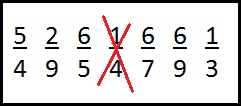Different fractions on a number line

Using the fractions in the box above, write the fractions in their correct positions on the number line below.
14 has been done for you.

| Y8 (11/07) | |
|
In order from left to right: 2/9 , 1/3 , 6/9 , 6/7 , 6/5 , 5/4 One error, e.g., 2/9 , 1/3 , 6/9 , 6/7 , 5/4 , 6/5 or 2/9 , 1/3 , 6/7 , 6/9 , 6/5 , 5/4 or 2/9 , 6/9 , 1/3 , 6/7 , 6/5 , 5/4 |
moderate easy difficult moderate difficult difficult difficult
|
Based on a representative sample of 163 students.
NOTE: An error can be a transposition of two fractions, an omission, or a fraction written incorrectly.
The important ideas in this resource are being able to recognise and place:
- fractions with the same numerator and different denominator
- fractions with a denominator that is a factor or multiple of another
- improper fractions (also called top heavy fractions, where the numerator > denominator).
Over half of the students recognised that 6/5 and 5/4 were improper fractions and therefore greater than 1. However, some of these students indicated that 6/5 was greater than 5/4 – suggesting a whole number influence on their thinking.
| Common error | Likely misconception |
|
1/3 , 5/4 , 6/5 , 6/7 , 2/9 , 6/9 (denominator then numerator) 1/3 , 2/9 , 5/4 , 6/5 , 6/7 , 6/9 (numerator then denominator) |
Ordering by denominator and then numerator (or vice versa) Students have a misconception about the relationship between the denominator and numerator. They try to relate the two numbers by ordering by numerator first, then using denominator (or vice versa) to determine the final order. |
| 1/9 , 5/3 , 2/9 , 6/7 , 6/5 , 6/4 |
Whole number misconception (application) Students combine the top and bottom number in some way and order them as whole number values. Students may be applying the rule: "the larger the numbers the larger the fraction". |
| 2/9 , 1/3 , 6/9 , 6/7 , 5/4 , 6/5 |
Transposing improper fractions Students order most of the fractions correctly but revert to a whole number understanding to order 5/4 and 6/5 (i.e., 6 & 5 are larger than 5 & 4). |
Students who have misconceptions that involve using whole number rules or ordering by denominator and numerator separately, need to develop a part-whole understanding of fractions before trying to devise a system to order or compare fractions. This is about recognising that a fraction is a part of a whole, and that it is the relationship between the top and bottom number that describes and quantifies the fraction, i.e., it is about the relationship between the numbers, not their absolute size.
If required, students could go back to partitioning and explore constructing the parts (unit fractions), then combining these parts to make up and name fractions. Encourage students to explore a range of less familiar fractions such as 3/13 , 11/27 , etc, and some improper (top heavy) fractions and discuss how large these fractions are. After this, encourage students to compare just two fractions before trying to order a number of them. Appropriate drawing of fractions can promote understanding and help with comparing the size of fractions.
Transposition of two fractions, omission, or fraction written incorrectly
For students who misplace 1 or 2 fractions, ask them to explain how they know that the misplaced fraction is larger or smaller and to show this using a diagram. They can begin by partitioning a rectangle, showing each fraction, and then comparing them. For a resource about comparing fractions see NM0138: Larger fractions (level 3).
Not recognising improper fractions
For students who did not recognise 5/4 and 6/5 as being greater than 1, draw another number line, partition the number line into appropriate unit fractions and build up the non-unit fractions and improper fractions, e.g., 1/5 , 3/5 , 6/5 ; 7/5 … or 1/4 , 3/4 , 5/4 ; 7/4 , etc.
Correct placement of all six fractions
For students who could place all six fractions correctly, use a number line between 0 and 2 and explore a range of improper (and mixed) fractions, showing where they think they might go.
Book 7: Teaching Fractions, Decimals and Percentages, 2006:
Trains (p.19) Early additive/Advanced additive/Early multiplicative.

